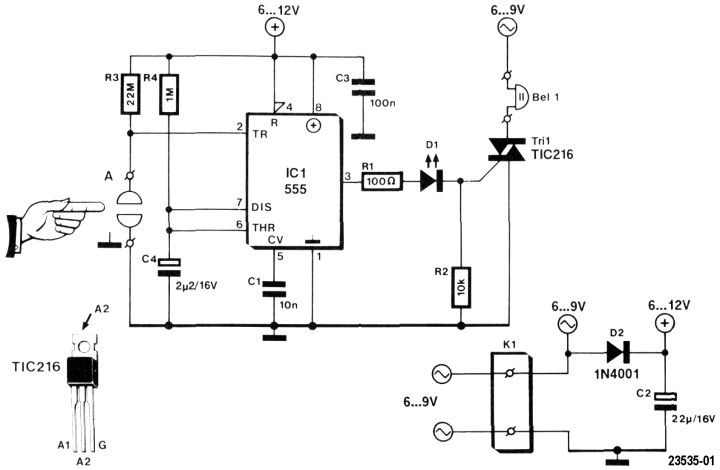Small Circuits Revival (48): Touch Doorbell
on
Touch Doorbell
Idea: Elektor Lab
The great advantage of a touch button or switch is the absence of mechanical parts — what is not in it cannot be broken. Because old-fashioned doorbell push buttons are exposed to wind and weather, they become unreliable over time. So why not replace them with a touch button?
Figure 1 shows the diagram of our touch doorbell. The touch switch on the left side consists of two pieces of metal close to each other (how you construct it is left to your imagination). As soon as both contacts are touched, the rather large (about 1 MΩ) skin resistance allows a small current to flow to ground via resistor R3. Because R3 is very large (22 MΩ!), pin 2 of IC1 is pulled down enough to trigger the good-old 555.

The 555 is used here as a re-triggerable monostable multivibrator ("monoflop"). As soon as it is triggered, its output pin 3 becomes high and the triac Tri1 is triggered via R1 and D1. This triac then conducts and the bell rings.
At rest (nobody is pressing the bell), pins 6 and 7 of IC1 are held high by R4 (C4 is loaded). As soon as the touch button is touched, C4 is very quickly discharged via pin 7 ("discharge"). After releasing the touch button, it takes a while before C4 is charged again to the value of the supply voltage. This means that also pin 6 (threshold) remains low, with the result that the output of the IC even after releasing the touch button remains high. The triac continues to receive a gate current and the bell continues to ring.
The bell is powered directly from the ringing transformer, which is an alternating voltage and ensures that the triac "automatically" switches off as soon as it no longer receives gate current. From that bell alternating voltage a DC voltage is derived with D1 and C2 that is used to power the electronics.
The structure of the circuit is not critical at all — perf board is excellent. Of course, it must be waterproof, and the touch button (two pieces of stainless metal) must be arranged in such a way that the bell cannot be triggered by a raindrop.
A propos raindrop: This circuit can of course also be used as a rain detector.
Want to learn about more small circuits? Check out our recent articles.


Discussion (1 comment)